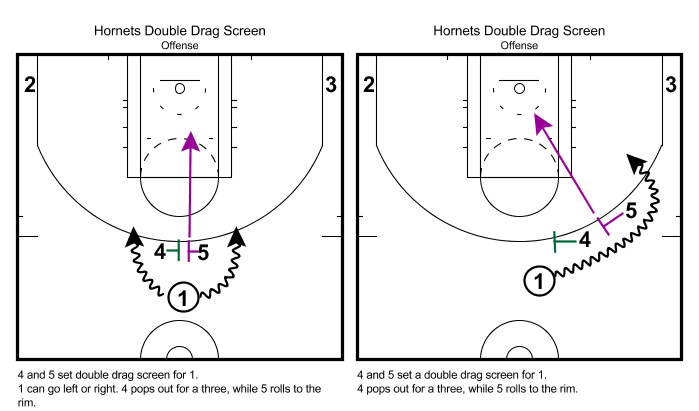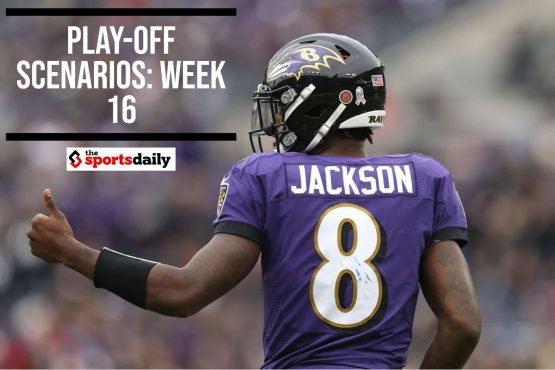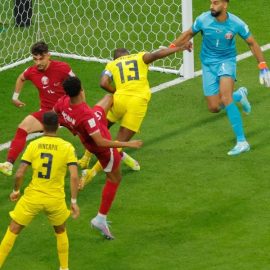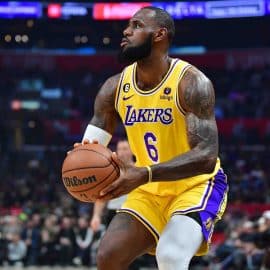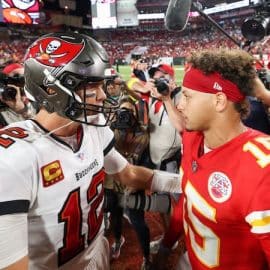13 games into their 2016-2017 NBA season, the Charlotte Hornets are currently winning 61.5% of their games, which means they’re on pace to win 50.4 games this season, a record that would be way over what Vegas had them projected to finish (42.5 over/under) with before the season even began.
Despite seeing 40% of their team roster changed over the offseason, the 2017 Hornets are still possessing one staple that helped them earn a playoff seed last season – a top 10 defense.
Let’s dive into how the Hornets are doing on both sides of the floor and use both what the data says, and what the game tape provides as well.
The Positives on Offense
Spreading the floor – Outside of Cody Zeller, Michael Kidd-Gilchrist (MKG) and Roy Hibbert, all of the other core players for the Hornets are capable 3-point shooters, which allows the Hornets to spread the floor with most of their lineups in games. The Hornets take the 5th most 3-pointers per game (30.5 3PA) and knock down 35.1% of those looks as a team, which is slightly above league average (13th).
One of the key sets on offense the Hornets use is their double drag screen, which is pictured below.
As you’ll see in the clip below, usually there’s a rolling big and shooting big involved in the double drag screen for either Kemba Walker or Ramon Sessions. The guards can either attack the rim to shoot or pass, while one of the bigs can constantly play the pick-and-pop action to get an open look, while wing shooters stand in the corners.
[protected-iframe id=”a4f3385ba8d7fbda237aa45bf8f60b08-114320562-25928832″ info=”https://streamable.com/e/4b7l” width=”560″ height=”278″ frameborder=”0″ scrolling=”no”]Walker is currently shooting 41.3% from beyond the arc on 7.1 attempts per game. The bigs who can shoot – Frank Kaminsky (4.6 threes at 33.3% shooting), Marvin Williams (6.2 threes at 32.5% shooting) and Spencer Hawes (1.3 threes at 26.7% shooting) all make the action difficult to guard for defenses, due to their ability to pop or roll as well. The Hornets generate 25.5 above the break 3s per game (ranked 3rd most) and knock down 34.6% of those looks from beyond the arc. The double drag screen is one of multiple sets that helps Charlotte get those above the break looks.
When the Hornets have rolled out the lineup of Walker, Marco Belinelli, Batum, Kaminsky and Zeller for 29 minutes this season, they’re a dangerous group with shooting all over the floor and Zeller’s ability to be a dive man off picks. The group pours in the points with 153.5 points per 100 possessions, while they take a hit defensively in giving up 115.5 PP/100, but, the offensive outweighs the defensive sacrifice, as they’re outscoring opponents by 38.0 PP/100 with that lineup.
Belinelli is currently knocking down 48% of his 3.8 threes per game, and if you’re a shooter and want to know how to get a good open look in the corner in transition, study Belinelli’s game. As you’ll see in the clips below, countless times Belinelli uses the pump fake to shed defenders and get wide open efficient looks from the corner.
[protected-iframe id=”252249a8b69e17369b05d9ec7be29af3-114320562-25928832″ info=”https://streamable.com/e/oaey” width=”560″ height=”278″ frameborder=”0″ scrolling=”no”]Getting to the free throw line – Led by Walker’s aggressive play, the Hornets also frequently get to the free throw line at a Top-10 rate. The Hornets visit the line 25.8 times per game (ranked 7th in the NBA). The quartet of Walker, Zeller (rim roller), Batum (driver), and MKG (driver, crashes glass) get to the line for a combined 18.3 free throw attempts per game.
Even though MKG isn’t known as an outside shooter (he’s taken just three 3-pointers all season), he is staying active on offense by crashing the glass 2.0 times per game, and he grabs a team high 8.3 rebounds per game.
Taking care of the basketball – Overall offensively, the Hornets are on the cusp of being a Top-10 offense with an Offensive Rating of 104.5 PP/100 (ranked 12th). The Hornets do play at an average pace (99.71 possessions per 48 minutes, ranked 13th) and with a slower pace, they’re able to take care of the basketball. The Hornets are ranked first in limiting their own turnovers (11.2 turnovers per game), and they work together like a machine, as they assist on 65.2% of their made baskets (ranked 2nd in the league). They also dish 24.3 assists per game (ranked 3rd in the NBA), and because they don’t turn the ball over much, defenses can only score 11.5 points off turnovers against the Hornets each night. This means the Hornets are one of those teams that don’t beat themselves, which allows them to have a chance to win in most ball games.
Despite having to handle 29.9% of the team’s offensive possessions, Walker is only turning the ball over 1.7 times per game. That’s pretty remarkable considering he takes the most shots on the team (whether in the system or in isolation situations) and he has to make plays for others as well.
In the starting five, Batum is the team’s second playmaker (19.7% usage), with Williams (18.6% usage) and Zeller (18.4% usage) right after he and Walker. Together, the normal starting five with Zeller at center are outscoring teams by 15.1 PP/100 in 150 minutes. With Zeller suffering a shoulder injury recently, Hibbert has had to start, and the offense has dramatically taken a hit, as that group is barely outscoring teams by 2.4 PP/100.
Over the summer, the Hornets lost Al Jefferson, who was one of their key pieces off the bench and also a post-up option when the pick-and-roll or drive-and-kick action were having trouble. With Jefferson gone, it looks like the Hornets have given that 6th man responsibility to the young Kaminsky, as he has the second highest usage percentage on the team (23.2% usage). When watching film, not only are the Hornets using Kaminsky as a pick and roll/pop option, but they’re also now running more post-ups for him to either score or move the ball around.
The Positives on Defense
Rebounding – The Hornets grab 36.5 defensive boards per game (ranked 2nd), and it’s not just the bigs grabbing boards, as MKG and Batum combine for 12 defensive rebounds per game too. Keeping teams off the glass (9.2 opponent offensive rebounds, ranked 6th best), means the Hornets’ defense doesn’t have to worry much about opponent second chance points (12.4 points, 8th best).
Protecting the Paint – While giving away too many 3-pointers has been an issue for the Hornets’ defense early on in the season, controlling and limiting points in the paint has been one of their positives. The Hornets are holding teams to just 39.7 points in the paint per game (ranked 6th best). They’re blocking 5.3 shots per game (ranked 9th best) and MKG as a shooting guard is swatting 1.1 shots per game.
Taking away the rim means teams are having to shoot jumpers, and though teams are making a good chunk of 3s against the Hornets, overall, Charlotte is limiting teams to 43.6% shooting from the floor (ranked 7th best).
Keeping teams off the line – Keeping teams off the free throw line is another key element of why the Hornets have the fourth best defense in the league (100.7 PP/100). The Hornets as a team only foul opponents 17.7 times per game (5th best), and teams only get to shoot 18.7 free throws per game against the Hornets’ defense (ranked 2nd lowest).
The Negatives on Offense
Lack of fast break opportunities & points in paint – With the slow pace the Hornets play at (99.71 PP/48), they really put a lot of emphasis on their half-court offense to generate their points. The Hornets only get 10.8 points from the fast break (ranked 25th) and as a whole, they shoot just 43.3% from the floor (ranked 26th).
In taking the 5th most three-pointers in the NBA, the Hornets have a roster mainly built to generate outside looks aside from Walker, and the rolling 5s. The Hornets score 40.6 points in the paint per game (ranked 23rd) and get into the teeth of the defense (restricted area) 25.8 times per game (ranked 20th).
The Negatives on Defense
Allowing too many 3-pointers – Though defense is the Hornets’ strength, allowing 3-pointers is their main weakness on the defensive end of the floor. The Hornets allow teams to shoot 31.3 threes per game (ranked 30th), which made me double check that number since one wouldn’t expect a Top-5 defense to allow that many threes. Teams are making 10.6 threes against the Hornets each night (ranked 29th).
From the corners, teams are shooting 7.1 threes per game (ranked 24th), but making just 29.3% of them (ranked 2nd best). From the above the break 3-point line however, teams are shooting 24.2 threes per game (Ranked 30th) and making 35.4% of those looks, which is around league average.
So, how can this be? How can a Top-5 defense allow this many threes? Is it scheme, or is it mistakes? I went back and watched some film of the threes the Hornets have given up, and my observations have shown it is a little bit of both scheme and mistakes on defense.
With the corner threes teams are getting against the Hornets, those are mainly coming off weakside help. For example, when a team runs a spread pick-and-roll action on the left side, the ball handler might drive into the paint on the left and kick out to the weakside shooter in the right corner. That pass is difficult to make, but enough teams are making the pass successfully against the Hornets to see that the defender guarding the corner shooter is helping way too much and he’s not getting back in time to contest the shot. There were also instances where the defender fell asleep and lost sight of a corner shooter, while, drive-and-kick action that led to swing passes to the corner were also areas of difficulty for the Hornets in guarding corner threes.
On above the break 3s, those mainly came off drive-and-kick action from teams, as the Hornets’ other defenders might help too far in and not recover in time to contest the shot, or not get back in rotations. In playing Zeller and Hibbert at the 5, those two defenders typically go under screens above the break on defense, and teams have sniffed out what they’re doing and taken advantage by shooting the open 3s when the bigs go under screens. The Hornets have also been caught helping too much when guarding post-up players, where the defender requires assistance with a double team.
Overall, so long as they can stay healthy and correct their team controlled issues (limiting opponent threes, picking up the tempo on offense), while also continuing to do the things they’re really good at on both ends of the floor, the Hornets should be in prime position come April to not only be near that 50-win mark, but also possibly trying to grab a top-4 seed for the playoffs in the Eastern Conference.
Stats gathered from NBA.com/stats
Add The Sports Daily to your Google News Feed!

